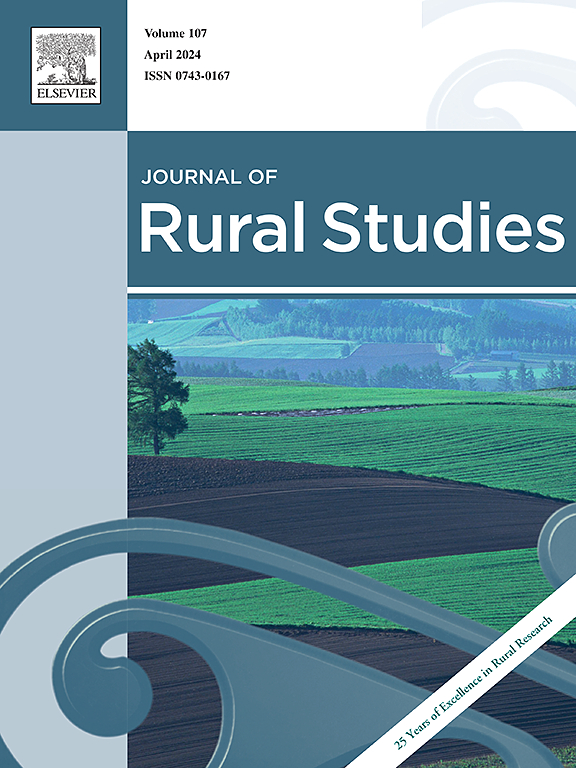基于弹性与活力的农用地系统转型——以榆林黄土高原为例
IF 5.1
1区 社会学
Q1 GEOGRAPHY
引用次数: 0
摘要
农地制度变迁可经历三种类型:波动型、可持续转型型和不可持续转型型。制定有针对性的政策以促进农业土地系统的可持续转型,可以为实现无贫困(可持续发展目标g1)、零饥饿(可持续发展目标g2)和陆地生态系统的可持续利用(可持续发展目标15)等可持续发展目标提供保障。然而,这需要一个全面的框架来确定农业土地制度的过渡是否可持续。因此,本文选择生态环境脆弱、农业历史悠久、人地关系紧张的黄土高原(榆林)作为案例区,通过构建系统弹性与活力相结合的概念框架,探讨农用地系统转型的特征、机制和调控路径。结果表明:2013年前后,在社会经济发展(城市化、经济增长和技术创新)和自然环境变化(气候变化和环境变化)的驱动下,黄土高原农用地系统经历了一个不可持续的转型过程,这一过程受到国家和地方战略政策的调控。系统弹性的快速提升主要归功于人力投入子系统(41%)和农业产出子系统(39%),而显著下降的活力主要由自然支持子系统维持。因此,增强人力投入子系统和农业产出子系统的活力是促进黄土高原农用地系统可持续转型的优先选择。在县域新型城镇化和乡村振兴战略下,减少农业劳动力,提高农业机械化水平和农用化学品(如化肥、农药、薄膜)利用效率,加快农业产业发展和农民增收,推广休耕轮作和气候智能型农业管理模式是提高农地系统可持续性的有效措施。此外,本文提出的农用地系统变迁分析框架具有可行性和可信性,具有应用于人类-环境系统和社会-生态系统的潜力。本文章由计算机程序翻译,如有差异,请以英文原文为准。
Agricultural land system transition based on resilience and vitality: A case study on the Loess Plateau (Yulin, China)
Agricultural land systems can undergo three types of changes: fluctuation, sustainable transition, and unsustainable transition. Developing targeted policies to promote the sustainable transition of agricultural land systems can provide guarantees for the achievement of sustainable development goals such as no poverty (SDG1), zero hunger (SDG2), and sustainable use of terrestrial ecosystems (SDG15). However, this requires a comprehensive framework to determine whether the transition of agricultural land systems is sustainable. Therefore, the Loess Plateau (Yulin), with its fragile ecological environment, long agricultural history, and tense human-environment relations, was selected as the case area to explore the characteristics, mechanisms, and regulatory pathways of agricultural land system transition, by constructing a conceptual framework that integrated system resilience and vitality. The results indicated that driven by socio-economic development (urbanization, economic growth, and technological innovation) and natural environmental changes (climate change and environmental change), agricultural land systems on the Loess Plateau underwent an unsustainable transition around 2013, which was regulated by national and local strategies and policies. The rapid improvement in system resilience was attributed to the human input subsystem (41 %) and the agricultural output subsystem (39 %), while the significant declining vitality was mainly maintained by the natural support subsystem. Therefore, enhancing the vitality of the human input subsystem and the agricultural output subsystem was a priority choice to promote the sustainable transition of agricultural land systems on the Loess Plateau. Under the new urbanization carried by counties and rural revitalization strategy, reducing agricultural labor force, improving agricultural mechanization level and utilization efficiency of agricultural chemicals (such as fertilizers, pesticides, and films), accelerating agricultural industry development and farmers' income increase, popularizing fallow rotation and climate intelligent agricultural management models would be effective measures to heighten the sustainability of agricultural land systems. Moreover, the analytical framework of agricultural land system transition presented in this study was feasible and credible, and had the potential to be applied in human-environment systems and social-ecological systems.
求助全文
通过发布文献求助,成功后即可免费获取论文全文。
去求助
来源期刊

Journal of Rural Studies
Multiple-
CiteScore
9.80
自引率
9.80%
发文量
286
期刊介绍:
The Journal of Rural Studies publishes research articles relating to such rural issues as society, demography, housing, employment, transport, services, land-use, recreation, agriculture and conservation. The focus is on those areas encompassing extensive land-use, with small-scale and diffuse settlement patterns and communities linked into the surrounding landscape and milieux. Particular emphasis will be given to aspects of planning policy and management. The journal is international and interdisciplinary in scope and content.
 求助内容:
求助内容: 应助结果提醒方式:
应助结果提醒方式:


